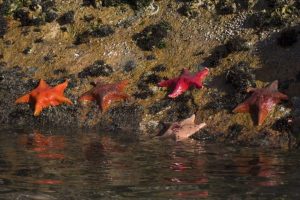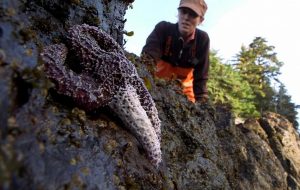Pisaster Disaster: Sea Star Wasting Disease along the Pacific Coast: Webinar Recording
Free online lecture recording with Melissa Miner
This Zoom webinar event occurred live on April 1, 2021.
Please click the link below to view the recording:
Pisaster Disaster: Sea Star Wasting Disease
First noticed in 2013, a mysterious disease has crippled sea star populations along much of the west coast. The outbreak, dubbed sea star wasting disease, caused many sea star species to die in record-breaking numbers over a short period of time. Among the hardest hit was the keystone species known as the ochre sea star (Pisaster ochraceus), which occurs on the Santa Barbara coastline. The disease continues to persist at low levels from Baja California to Alaska, and while populations are trending toward recovery in some regions, other areas have shown few signs of rebounding. The outlook for recovery varies by species as well, with species such as the ochre star faring better than others, such as the sunflower star (Pycnopodia helianthoides). Melissa Miner, a research specialist from the University of California Santa Cruz’s Long Marine Lab works with the Multi-Agency Rocky Intertidal Network (MARINe) monitoring sea stars and other intertidal organisms along the west coast. Melissa has played a key role in the effort to collect and centralize monitoring data from over 200 coastal ecosystems between Alaska and Mexico and to track the progression of the disease over time. She and her colleagues from MARINe examine the effects of the disease on various sea star populations, and how the decline in sea stars impacts the greater community as a whole. Because sea stars eat many other organisms, Melissa and MARINe have already noticed changes in the biological communities in which the sea star populations have declined.
For over 25 years, Melissa Miner has played a key role in the collection and synthesis of long-term monitoring data from rocky intertidal communities from Alaska to Mexico as part of MARINe. She began her career at UCSB, monitoring sites along the Santa Barbara mainland and Channel Islands, and has worked her way north. She is a researcher at UC Santa Cruz, but works remotely from Bellingham, WA, with her husband, twin teenage boys, and a fluffy rescue mutt.










